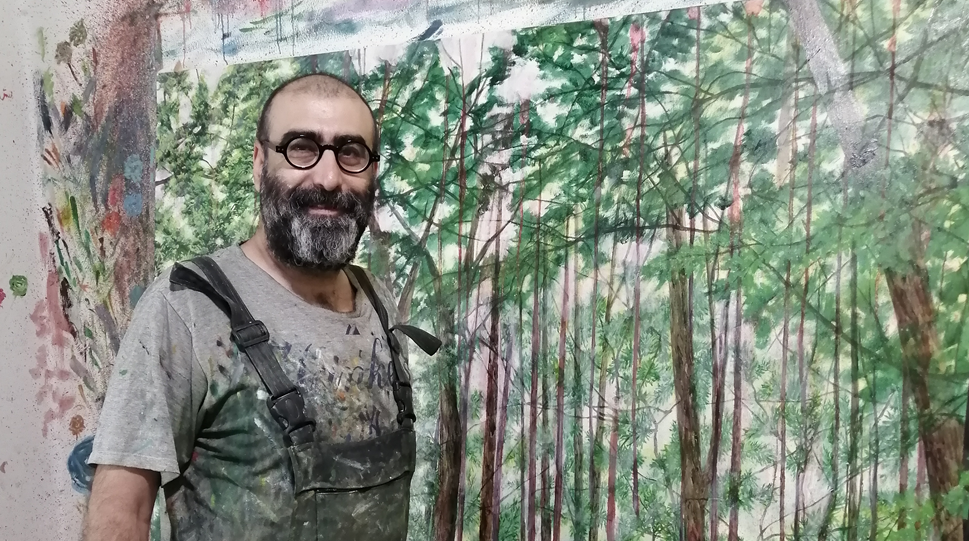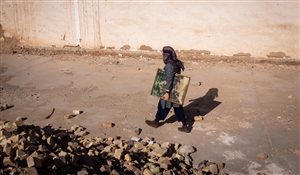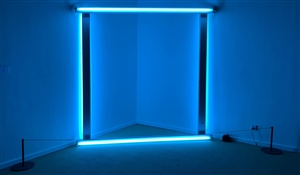Control Samples: Behrang Samadzadegan in Conversation with Amirhossein Bayani
29 Jun 2023Interviewer: Behrang Samadzadegan
- Let's start with "Out of Context"; the series that in my opinion is one of your most important ones. Although it was first presented in 2016, it has been discussed among your audiences since then and is still being shown in various exhibitions today. As a critic, after following the journey of the series, I felt this is the right time to discuss it with you. I'd like to know what you think about this journey.
You are right. This series has had many ups and downs. I feel like, in the beginning, "Out of Context" didn't receive the attention it deserved inside Iran. However, it found its way over time. A curator advised me to continue these works and showed them in a solo exhibition in Boston, United States. Another curator saw the works in Boston and then showed them in a group exhibition in Massachusetts. And then another show happened in Norway. As you mentioned, many collectors in Iran still want to own a piece or two from "Out of Context". The fate of these pieces is also interesting and exciting to me.
- In your new series, you have had commonalities with your previous series that, as far as I know, are always a part of your career and are the result of your interaction with Persian painting. Throughout your career, there are different eras and one that stands out for me has been that you were among the first to make fun of Persian painting.
Back then I was at university, and how interesting that you still remember it.

- Persian painting as a result of post-modernist concerns in Iran's 60s and 70s with many of us dealing with it, you have never committed yourself to conserving the ideological structure of art history and moralistic, i.e. a sanctified, perspectives on Persian painting and, as I have mentioned, you manipulated Persian painting, in a way. And humorous content could usually be found in that kind of work as well. I am not trying to necessarily link your more recent series to this case, but what I am trying to get at is you have always made a connection to Persian painting through your personal and painterly concerns, but you have always deconstructed it. You have messed with the form that our mind unconsciously knows and has accepted as "the traditional", and you have challenged its being based on that foundation. Once in a while, you would add a humorous text, and in some cases, you have implicitly mixed it with historical, political content was prominent. Now in your new series, an important thing has happened, which is not shocking to someone who has always been following your works and is logical and the result of continuity, and it would be strange otherwise. You have attained an extreme level of deconstruction, separating the pictorial content and the narrative motif from the context, putting it in another one, which is the white, background wall. Linking it to other contexts that have no narrative relation to Persian narrative painting. What's going on this time? The first time I saw these works, I thought you are moving to a mixed structure, and it is like you are getting something as a figure and you want to develop it to another structure, but this does not happen and you are actually erasing the original context, putting it into a new one, and this can only be arranged in connection to "the traditional", and in fact, it only finds meaning in such a context. Because the form and its structure are only standing on its context, you are now erasing this context and transferring it to another context, which only leads to a rupture that destroys its whole form and structure; although your paintings are still very beautiful, even more so than the previous ones; you have maintained all your painterly concern, but you have destroyed the context almost completely and it is obvious that you are deliberately attaining nothingness. What do you think?
You have referred to two things. Firstly, you talked about my background, which was so interesting. When I was fourteen or fifteen years old, my mother got me a book of Persian paintings that I amazingly cherished. In retrospect, I think it would have been fit for me to have liked Mickey Mouse or something like that, but I liked a book of Persian paintings anyway. At university, as you already mentioned, I had such a concern, I liked Persian painting, and I still do. My attitude to Persian painting has always been in a way that I could borrow from it, and actually, to be able to use the potential of Persian painting to generate images and to mix them with my ideas. As you said yourself, in some cases it tended to be humorous. This caught my attention when I realized many of my fellow artists are exploiting this art to make money. Back then I tried to put it on hold to approach it later on with more resolution. In "Shahnameh", for example, I am faithful to it, but in more recent series, like in the one about the Persian woman, and the likes, I haven't been faithful to Persian painting at all. In the "Babylon System" series too. I say this because I might have come to Persian painting in cases that were related to the works, but not because I wanted to put myself in the context of the mainstream. Even in this series, some might think the works to be merely decorative, or according to what is in vogue, etc. but this should be considered that despite the interest I've always taken in these themes, I have avoided them in some cases, for I didn't want them to be interpreted in such a way, or to make sure that I am not thinking about such things unconsciously. But this time around, I've come to this matter quite deliberately, and as you rightly pointed out, this time I don't have a humorous approach anymore and my work is coming from a bigger idea. And your question was about how I have separated them from their contexts.

Amirhossein Bayani | Untitled | Oil on Wood | Tehran | 2016 | Source: www.amirhosseinbayani.com
- I'd like to emphasize, once again, that from where I stand, you have destroyed things by separating the works from their contexts. When we talk about Persian painting, we are talking about "the traditional", which is based on the preservation of the form and its framework. You have worked against the aforementioned backdrop, and I think the painterly pleasure in your work does not stem from the Persian miniature. In you, I have found a painterly behavior that no matter what you paint; I think you have achieved an understanding to use the painting in an operant manner, to achieve some other concept, apart from the pleasure you take in drawing anything. Now regardless of the painterly pleasure, you have messed with the form of "the traditional" and I see in your work a very interesting paradox, because when I look at them, they are aesthetically very masterful and spectacular, but behind them, there is destruction and vanishing because you have messed with the traditional framework. It would collapse by even taking one element away from it. I want to arrive at the next question. One of the differences between you and me had always been that I look at things from a literary point of view, but you, regarding your literary background, always take a philosophical, political approach. Here too you don't have that emotional and even semantic connection to literature, and you've had this relation to Persian painting, and right now you are destroying it. How would you define the destruction, and in what realm would you place it?
Well, in so many words, I can say that this destruction comes from my experience and study of politics, specifically from politics, and I'd like to emphasize that politics for me is not everyday politics. Politics is not a dialogue. For me, politics is not a result of a negotiation between Obama and the French president. Politics for me is political science. An approach to humanity that we know to this day from Plato and others. That's political for me and today it is more than ever. Regarding your question, I shall say, even though Persian painting has always fascinated me, that hasn't been my concern in this exhibition, and it could be about a text, or any text, instead. It could have been about the very paintings of Lucian Freud. It could have been the image of a city being built, or anything. For instance, if I would cut out the Eifel from Paris and put it in another context, what would happen to it? We're talking about the signified and signifier, what would happen if the relationship would be broken. And I finally find the answer in politics. We can consider the social or the ontology of the Eifel Tower in the context of Paris and so on. So this time Persian painting has been an excuse for me. I have used the images because I loved them, but the main point here is politics. And about my view on tradition and the presence of tradition in my works, you are right. But the destruction refers to politics.
- I think you bring about destruction in two systems or two regimes, one being the traditional aesthetics and the other the system of content. It seems that you have aimed to make a new system out of them, after having destroyed both. I want to arrive at the point at which you think your goals will become possible, and I want you to elaborate on that. In these works, you have taken away a skeleton and a frame, in the separation process, you have thoroughly destroyed those frames and you say these are made possible in the political realm. What has happened exactly and what dialectic has been formed?
I think we have two kinds of politics. One is the politics of power, which is based on agreements and differences; politics that sit us on two sides of a table to start and fight to resolve conflicts and to achieve a balance. Rancière believes that this is not politics of agreement. The politics of difference tries to minimize the disagreements, and in fact, politics means stepping out not stepping up. The politics of stepping out is the everyday politics and the politics of power and that politics is stepping up politics that I call the politics of emancipation. However, my series is about the politics of power; one that seeks to impose itself constantly, to gain the upper hand, and to constantly oppress others by inflicting itself as a subject. This type of politics never leads to emancipation. It always attempts to have an upper hand by using force, and the pretext is always required to justify it. Consider everything from the election to creating new regimes of power in different regions of the world. I think politics is constantly violating the organic unity of things and such is the nature of political violence that tries to empty the concepts of their essence, reproducing it to make new circumstances for negotiations. We can see this all the time. This is what I have done with Persian painting. I have to explain here that Iranian miniatures are often small and chaotic with wide compositions. These miniature, forms achieve the highest level of perfection, they are self-sufficient i.e. they produce and reproduce in themselves their aesthetic capacities, keeping it all inside so that the tiniest manipulation can cause them to collapse, as you just mentioned. In the chaos of a 20 centimeters miniature, a horse, a picture or any other element have proportions between one, two, or three centimeters. What politics are here is to remove the elements from their contexts. I have cut them and have put them out of their context. Then I blow them up, which means I inflict damage to their original form the second time. Then I see, for example when a 2cm soldier that is shaped by a simple stroke becomes one and a half meters, the previous quality won't do anymore, and so I have to produce in the new aesthetics, and so similarly, every time I make a change, and every time I use violence on them, aggrandizing them, it is like they are subjects of "discipline and punish", theoretical subjects for new discourses. I have to emphasize that "discourse" here is not that of "reformation". These are all pretexts for making new grounds for political discourses to carry on the power. So I have constantly used violence in these images until they are deprived of their essence. They are new images with new aesthetics, making possibilities for new criticisms and discourses. You can call them decorative, you can say they are meant to be sold, or you can say how beautiful they are, or masterful, or the opposite. The truth of these new discourses, I think, is to make crises. Inside the crises of politics, power can link its meditators and its relationship.

Amirhossein Bayani | Untitled | Oil on Wood | Tehran | 2016 | Source: www.amirhosseinbayani.com
- You have used violence. It can lead to content fallacies. If I got it right, you mean that, for example, the power hierarchy can be an aesthetic hierarchy that creates a structure that you bring out, not for liberation, not for abstraction, not to give them independent voices, but so they will be arranged in a new way, in a hierarchy riled by a patriarchal view, in order for them to remain under control.

Amirhossein Bayani | Untitled | Oil on Wood | Tehran | 2016 | Source: www.amirhosseinbayani.com
Exactly. It is the same old "big other" who always manages our conduct. As I mentioned in the statement, the exhibition takes its point of departure from within power to its boundaries in a paradoxical manner. The paradox is, I think, that by getting myself to the circle of power, I can discover new horizons for politics and freedom. This means that we can find signs of freedom even inside the circle of power and art, or the artwork can distance itself from this show and instead of making a representation, consider horizons inside which beauty can be perfected.
- To conclude this, perhaps I can point out that your pretext for symbolizing this political conflict, there is a powerful form called aesthetic tradition.
In a sense.
- I say this because today, even though artists such as you and I have a conceptual approach, we don't have an aesthetic conceptual approach, in the sense that we order the removal of the art object, and our perspective is still based on the same power of aesthetic, and, to mess this structure up, and to arrive at the limits of freedom, you have used the structure itself, which can be expanded to the non-aesthetic content of the political.
You are right.






